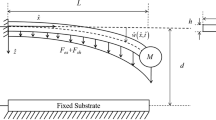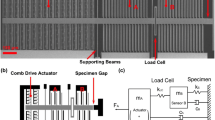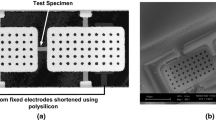Abstract
This work presents the modeling of gold microbeams for characterizing Micro-electro-mechanical systems (MEMS) packages in terms of both strains induced to the MEMS devices and hermetic sealing capability. The proposed test structures are based on arrays of rectangular-shaped clamped-free and clamped–clamped beams, to be realized with a film of electroplated gold by surface micromachining technology. The resonant frequency of the microbeams is modeled by FEM simulations as a function of substrate deformations, which could be induced by the package. Clamped–clamped bridges show a linear change of the square of the resonant frequency in case of in-plane deformations, in fairly good agreement with an approximate analytical model. Cantilever beams are modeled as variable capacitors to detect out-of-plane deformations. Finally, an analytical model to study cantilever beams as resonators for detecting pressure changes is discussed and compared with preliminary experimental results, showing an impact on the quality factor in a range from 10−2 mbar to 1 bar.







Similar content being viewed by others
References
Bouwstra S, Geijselaers B (1991) On the resonance frequencies of microbridges. In: Proceedings of 6th International Conference on Solid-State Sensors Actuators and Microsyst Transducers’91:538–542. doi:10.1109/SENSOR.1991.148932
De Coster J, Jourdain A, Puers R, Tilmans HAC (2005) A method to evaluate the internal cavity pressure of sealed MEMS devices. Proc. IMAPS-EMPC 2005:599–603
Giacomozzi F, Lorenzelli L, Margesin B, Turco G, Marcelli R (2003) MEMS technology for RF switches. Proc AISEM 2003:392–397
Gooch R, Schimert T, McCardel W, Ritchey B, Gilmour D, Koriarz W (1999) Wafer-level vacuum packaging for MEMS. J Vac Sci Technol A 17(4):2295–2299. doi:10.1116/1.581763
Hosaka H, Itao K, Kuroda S (1995) Damping characteristics of beam-shaped micro-oscillators. Sens Actuators A 49:87–95. doi:10.1016/0924-4247(95)01003-J
Jourdain A, De Coster J, De Moor P, Puers R, Tilmans HAC (2005) Hermeticity investigation of sealed 0-level packages based on the damping characteristics of the MEMS device. Proc IMAPS-EMPC 2005:222–227
Leedy KD, Strawser RE, Cortez R, Ebel JL (2007) Thin-film encapsulated RF MEMS switches. JMEMS 16(2):304–309. doi:10.1109/JMEMS.2007.892915
Lifshitz R, Roukes ML (2000) Thermoelastic damping in micro- and nanomechanical systems. Phys Rev B 61:5600–5609. doi:10.1103/PhysRevB.61.5600
Okada H, Itoh T, Suga T (2008) Wafer level sealing characterization method using Si micro cantilevers. Sens Actuators A 147:359–364. doi:10.1016/j.sna.2008.05.012
Pandey AK, Pratap R (2007) Effect of flexural modes on squeeze film damping in MEMS cantilever resonators. J Micromech Microeng 17:2475–2484. doi:10.1088/0960-1317/17/12/013
Tilmans HAC, Ziad H, Jansen H, Di Monaco O, Jourdain A, De Raedt W, Rottenberg X, De Backer E, De Caussemaeker A, Baert K (2001) Wafer-level packaged RF-MEMS switches fabricated in a CMOS fab. In: Proc IEDM, pp 921–924. doi:10.1109/IEDM.2001.979663
Veijola T, Kuisma H, Lahdenperä J, Ryhänen T (1995) Equivalent-circuit model of the squeezed gas film in a silicon accelerometer. Sens Actuators A 48:239–248. doi:10.1016/0924-4247(95)00995-7
Yang J, Ono T, Esashi M (2002) Energy dissipation in submicrometer thick single-crystal silicon cantilevers. JMEMS 11(6):775–783. doi:10.1109/JMEMS.2002.805208
Yasamura KY, Stowe TD, Chow EM, Pfafman T, Kenny TW, Stipe BC, Rugar D (2000) Quality factors in micron-and submicron-thick cantilevers. JMEMS 9(1):117–125. doi:10.1109/84.825786
Acknowledgments
The presented work is part of MEMSPACK, a collaboration between IMEC, VTT, FhG-ISiT, Univ. Perugia, FBK, IEMN-CNRS and MEMS TC (http://www.memspack.eu). MEMSPACK receives financial support from the European Commission in the FP7-ICT program, under grant agreement nr. 223882. The authors thank Martin Niessner and the group led by Prof. Gerhard Wachutka at Institute for Physics of Electrotechnology (Munich University of Technology) for providing the experimental setup and for technical support in Q-factor measurements.
Author information
Authors and Affiliations
Corresponding author
Rights and permissions
About this article
Cite this article
Faes, A., Resta, G., Solazzi, F. et al. Modeling of gold microbeams as strain and pressure sensors for characterizing MEMS packages. Microsyst Technol 18, 1139–1145 (2012). https://doi.org/10.1007/s00542-012-1457-5
Received:
Accepted:
Published:
Issue Date:
DOI: https://doi.org/10.1007/s00542-012-1457-5




